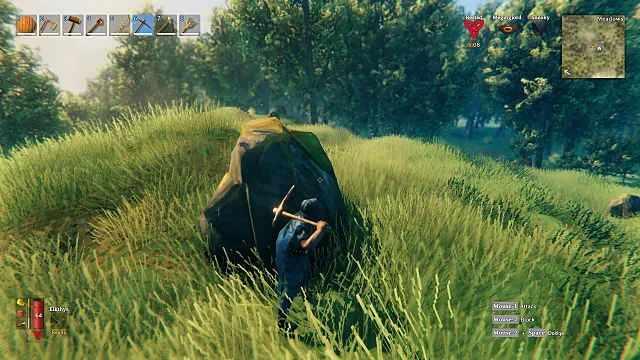To progress in Valheim and get new workbenches and crafting recipes, you have to build a shelter. You can’t even interact with the likes of the workbench or forge until you do so. While wood is readily available in most Valheim biomes, the real meat of constructing a hall fit for a Viking is set in building with stone.
In this building guide, I’ll cover what you need to know to start constructing your stone hall. I’ll also include tips and other bits of knowledge you’ll want in your toolbelt.
Valheim: Building with Stone

When building, you have to account for a few different variables, many of which I covered in our building basics guide.
As a quick refresher, though, the more your structure grows vertically, the more the structural integrity of that structure decreases. Thus, buildings are often limited in size, unless you get creative with supports.
Once you progress into the iron age of Valheim, however, it all changes. Iron leads to constructing stone structures, and stone is strong.
How to Get the Stonecutting Table
Once you’ve smelted iron into an iron ingot — a crafting resource found in the swamps rather abundantly in sunken crypts — you’ll be able to build the stonecutter table. Here’s the recipe:
- 10x wood
- 2x iron
- 4x stone
The stonecutter table gives you access to a number of stone building parts, including:
- Three types of stone wall
- >Stone arch
- Stone floor
- Stone pillar
- Stone stair
- Paved road
- Hearth
Now, all that’s holding you back is having the stone on hand to make your vision a reality. For that, I’d suggest crafting a cart, equipping the bronze or iron pickaxe, and going harvesting.
Harvesting Stone
You’ll find plenty of boulders to break down with your pickaxe in the Meadows biome, but of course, you can also find stone in the Black Forest, Swamp, and Plains. Aside from resource nodes, there are generally plenty of rocks lying on the ground that you can pick up and collect as well.
With a 2×2 stone floor requiring 6x stone, it’s safe to say you’re going to be gathering for a while for even a modest hall.
Structural Integrity
Stone is obviously stronger than wood, and it counts for full structural integrity, even if built to its max height.
For example, if you put down a stone floor and then build stone walls stacked three units high, then add a layer of wooden walls on top of that, the wood will be blue, its max integrity strength. The stone acts similarly to the ground in this instance.
With stone, you can more than double the height of your structures, meaning more room for hoarding all your gathered resources, as well as strong walls to help repel invaders.
It’s worth noting that stone floors can only be placed on the ground level and cannot connect to other stone floors in the way that wooden floors connect. Think individual slabs butted up to each other but not bonded together.
This means that, unless individually supported by either pillars or arches, floors are foundational only. Additional floors in your buildings will need to be wooden. And in my opinion, wooden floors are going to be the more cost-effective choice anyway.
From here, it’s really up to you how you want to go about incorporating stone when designing your structures. Hopefully, this quick guide helps you better understand the limitations of stone and just how useful it is to build a hall fit for a Viking in Valheim. If you’re new to Iron Gate’s survival game, consider checking out some of our other guides and helpful tips articles.






Published: Mar 1, 2021 07:47 pm